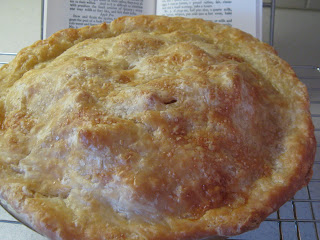Apples are not native to North America, so the Pilgrims
wouldn’t have enjoyed apple pie in their first years in the New World. However,
“planting apples orchards was among the first tasks the early settlers took,”
writes Peter Wynne in his 1975 book Apples:
History, Folklore, Horticulture, Gastronomy. Clergyman William Blaxton
planted the first orchard in Massachusetts in 1625, Wynne notes, as well as the
first orchard in Rhode Island in 1635. How far has the modern apple pie strayed
from the early American version? Not very, it appears. The one ingredient missing
from today’s apple pie is rose water. The first American cookbook, American Cookery, published in 1796, includes
this recipe for apple pie:
Stew and strain the apples, to every three pints grate the
peal of a fresh lemon, add cinnamon, mace, rose-water and sugar to your
taste—and bake in paste . . .
My version doesn’t require stewing the apples in advance. It
also eliminates the rose water, which isn’t readily available. Mace, the dried
outer covering of nutmeg, is available in the spice section of most grocery
stores, but if you can’t find it, substitute nutmeg.
Old-fashioned apple
pie
Crust:
2 cups flour
pinch salt
1 stick cold butter, cubed
½ cup or so of ice water
Sift flour into a bowl, add a pinch of salt. Add butter and
work in with pastry cutter. Add ice water slowly until dough holds together. Wrap
in plastic and refrigerate until ready to roll.
Filling:
6 to 8 large apples, peeled and sliced
Zest of a lemon
½ cup sugar
Mace (or nutmeg) and cinnamon to taste
Preheat oven to 375 degrees. Remove dough from refrigerator
and divide. Roll out each section to fit a 9-inch pie plate. Gently place first
round of pastry in pie plate. Do not stretch or press. Add filling. Top with
second round of pastry. Roll edges under and crimp to seal. Make three slits in
top of pie dough to vent steam. For a glossy crust, brush with milk, cream or
egg wash. Sprinkle with coarse sugar, if desired. Bake for 40 minutes or more,
until the crust is golden.

























